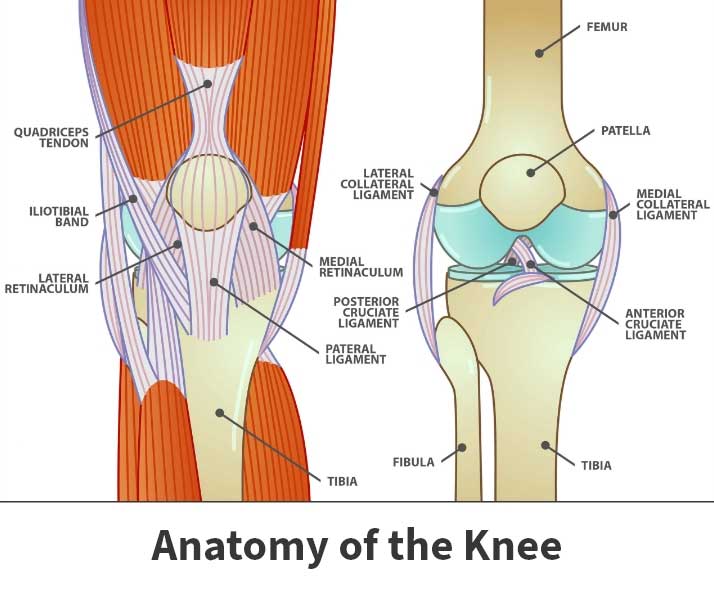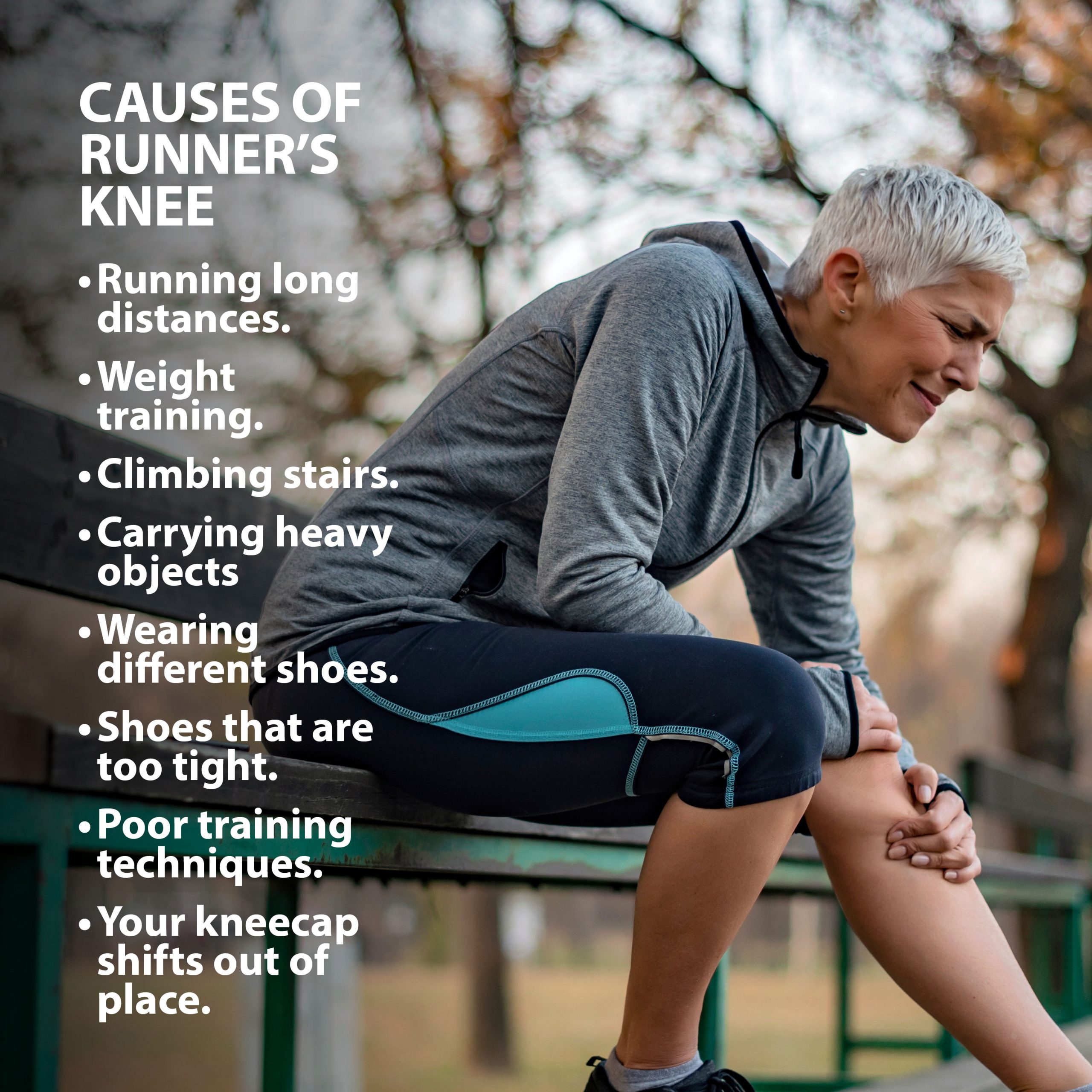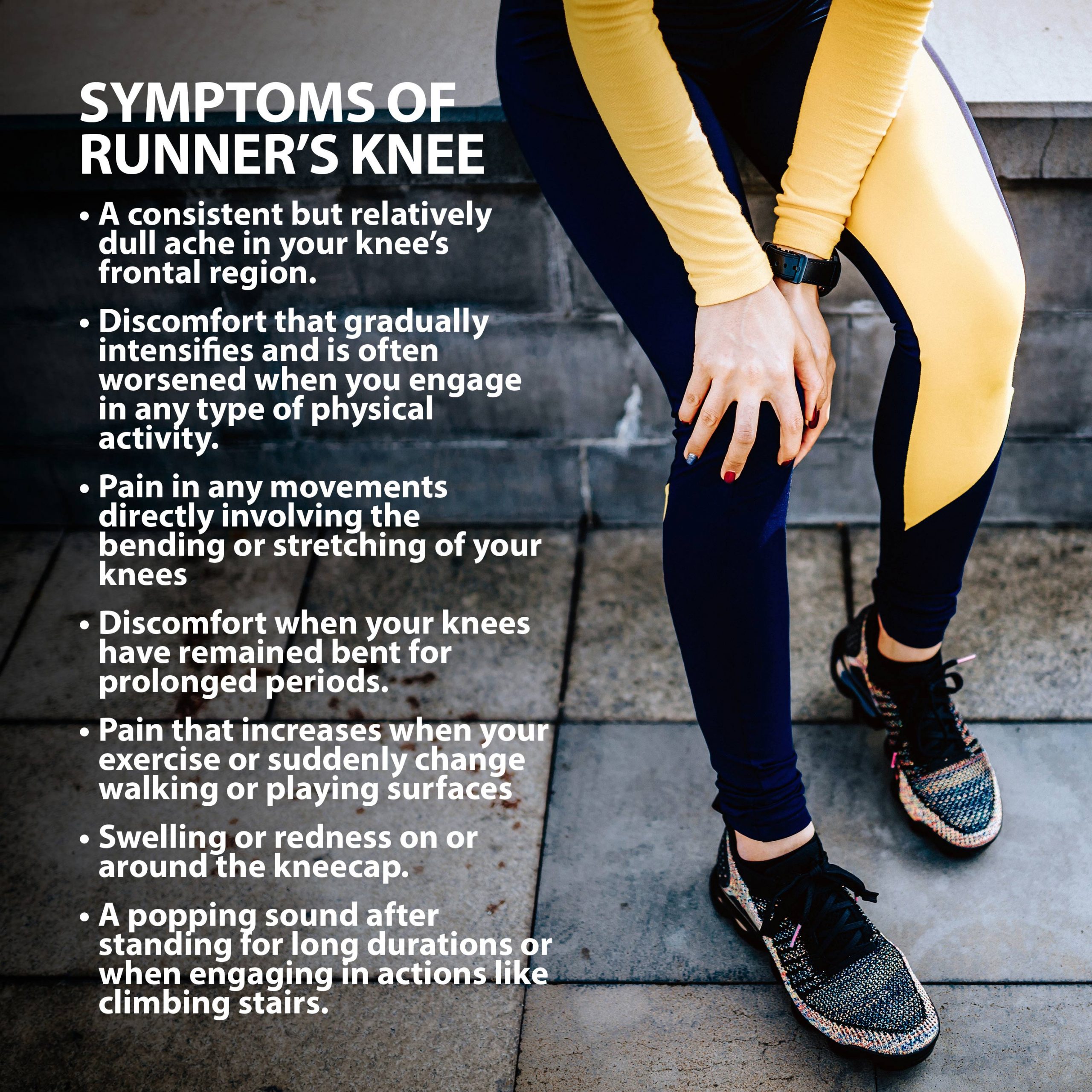Runner’s Knee
Overview
The knee is one of the body’s most important physical features. You could not move your leg in any direction or perform routine actions such as standing, bending, or walking without it. Additionally, the knee supports the upper body’s weight and helps you remain upright.
Considering the knee bears so many heavy responsibilities, it should not be surprising that it can suffer many injuries. One such occurrence is a condition known as runner’s knee, which in medical terms is called patellofemoral pain syndrome, or PFPS.
Anatomy
The knee is a major joint surrounded by a complex network of bones, muscles, and soft tissues like tendons and ligaments. Three bones connect to the knee joint: the thighbone (femur), the kneecap (patella), and the shinbone (tibia).
Several ligaments and tendons connect the knee joint to bones and its surrounding muscles to bones. Additionally, cartilage is also present in the knee joint. Cartilage cushions bones and enables the knee to move more freely and easily.

Description
Runner’s knee occurs when your kneecap or its surrounding tissues experience inflammation or structural damage.
Causes
Several underlying problems can cause runner’s knee. Sometimes, this issue results from the breakdown of cartilage surrounding the knee cap. In scientific terms, this condition is called chondromalacia patella.
You are far more likely to experience runner’s knee if you are physically active. Furthermore, your chances of contracting the condition increase dramatically if you place consistent and significant stress on your knee. Such actions include:
- Running long distances.
- Weight training activities like squats.
- Climbing stairs routinely.
- Carrying heavy objects for extended durations or long distances.
The condition is often brought on or worsened by taking part in such activities with greater frequency or using increased intensity when performing them.
Sometimes, wearing different shoes can place additional strain on your legs and knees. Shoes that are too tight can hinder mobility and leave you more susceptible to knee injuries.
Occasionally, runner’s knee can be the result of poor training techniques. For example, failing to stretch or loosen the knees before exercising can increase your risk. Beginning an intense activity your body is not yet equipped to handle can also increase your chances.
Sometimes, the injury can occur when your kneecap shifts out of place. This can often irritate surrounding cartilage and soft tissues, leading to inflammation.

Symptoms
Typically, the most common symptom you will experience is a consistent but relatively dull ache in your knee’s frontal region. This discomfort gradually intensifies and is often worsened when you engage in any type of physical activity. Other symptoms include:
- Pain in any movements directly involving the bending or stretching of your knees.
- Discomfort when your knees have remained bent for prolonged periods.
- Pain that increases when your exercise or suddenly change walking or playing surfaces.
- Swelling or redness on or around the kneecap.
Additionally, you might hear a popping sound after standing for long durations or when engaging in actions like climbing stairs.

Diagnosis
Runner’s knee can prove challenging to diagnose because its symptoms are like other knee issues. Your doctor will closely examine your knee and may ask you to perform certain movements. How you respond to these tests can help them recognize the condition’s presence.
Your physician may use diagnostic tools like x-rays, computerized tomography (C.T. scans), or magnetic resonance imaging (M.R.I.s) to confirm the diagnosis. These tools capture internal scans of your knee, which could reveal associated underlying problems such as kneecap displacement, cartilage damage, or soft tissue inflammation.
Treatment Overview
Surgical intervention is rarely needed to correct runner’s knee. Usually, home remedies or nonsurgical therapies lead to improvement.
Nonsurgical Treatment Options
Should your doctor diagnose you with runner’s knee, they will likely recommend a course of home therapy. Home care is typically started with a first aid practice called R.I.C.E. – short for Resting the injured knee, Icing the affected area, Compressing the knee to prevent unnecessary shifting, and Elevation, which increases blood flow to the wounded area and stimulates the healing process.
Other forms of home treatment can include over-the-counter medications like non-steroidal anti-inflammatory drugs, (NSAID’s) such as aspirin, ibuprofen (Motrin, Advil) and naproxen (Aleve), to relieve your pain.
More moderate instances of runner’s knee might benefit from treatments like:
- Physical Therapy – A physical therapist creates exercises tailored towards improving your injured knee’s strength and range of motion.
- Orthotics – Orthotics are cushioning materials placed inside your shoes to provide greater stability and reduce stress on your feet and ankles. They are designed to relieve excess pressure on your knees.
Surgical Treatment Options
Only the most severe instances need surgery. The most common surgical procedure performed is arthroscopy. During this process, your surgeon inserts a small device equipped with a camera inside the knee. Then they use the images displayed by the camera to identify problem areas and make needed corrections.
Specific corrections include debridement, in which damaged cartilage is removed from the kneecap. Another is lateral release. During this process, surgeons stretch surrounding tendons to readjust the ill-positioned kneecap.
Next Steps
If you have been diagnosed with runner’s knee or have symptoms indicating that you might, we look forward to helping you. After a comprehensive examination, our experienced and skilled knee specialists can determine the best treatment plan. Talk to your Florida Orthopaedic Institute physician today to learn more about runner’s knee.
Areas of Focus
- Knee & Leg
- ACL Injuries
- Arthroscopic Chondroplasty
- Articular Cartilage Restoration
- Deep Thigh Bruising
- Fractures Of The Tibial Spine
- Iliotibial Band Syndrome
- Lateral Collateral Ligament (LCL) Injuries
- MACI
- Medial Collateral Ligament Injuries
- Meniscus Tears
- Muscle Spasms
- Muscle Strains of The Calf
- Partial Knee Replacement
- Patellar Fracture
- Quadriceps Tendon Tear
- Runner's Knee
- Senior Strong
- Shin Splints
- Total Knee Replacement Surgery
The following Florida Orthopaedic Institute physicians specialize in runner’s knee:
Specialties
- AC Joint Injuries
- Achilles Tendinitis - Achilles Insertional Calcific Tendinopathy (ACIT)
- Achilles Tendon Rupture
- Achilles Tendonitis
- ACL Injuries
- Ankle Fracture Surgery
- Ankle Fractures (Broken Ankle)
- Ankle Fusion Surgery
- Anterior Cervical Corpectomy & Discectomy
- Arthroscopic Articular Cartilage Repair
- Arthroscopic Chondroplasty
- Arthroscopic Debridement of the Elbow
- Arthroscopy Of the Ankle
- Articular Cartilage Restoration
- Artificial Disk Replacement (ADR)
- Aspiration of the Olecranon Bursa - Fluid In Elbow
- Atraumatic Shoulder Instability
- Avascular Necrosis (Osteonecrosis)
- Bankart Repair
- Basal Joint Surgery
- Bicep Tendon Tear
- Bicep Tenodesis
- Bone Cement Injection
- Bone Growth Stimulation
- Bone Health Clinic
- Broken Collarbone
- Bunions
- Bursitis of the Shoulder (Subacromial Bursitis)
- Calcific Tendinitis of the Shoulder
- Carpal Tunnel Syndrome
- Charcot Joint
- Chiropractic
- Clavicle Fractures
- Colles’ Fractures (Broken Wrist)
- Common Foot Fractures in Athletes
- Community Outreach
- Cubital Tunnel Syndrome
- De Quervain's Tenosynovitis
- Deep Thigh Bruising
- Degenerative Disk Disease
- Diffuse Idiopathic Skeletal Hyperostosis (DISH)
- Discectomy
- Discitis Treatment & Information
- Dislocated Shoulder
- Dupuytren’s Disease
- Elbow
- Elbow Bursitis
- Elbow Injuries & Inner Elbow Pain in Throwing Athletes
- Epidural Injections for Spinal Pain
- Finger Dislocation
- Flexor Tendonitis
- Foot Stress Fractures
- Foot, Ankle & Lower Leg
- Foraminotomy
- Fractured Fingers
- Fractures Of The Shoulder Blade (Scapula)
- Fractures Of The Tibial Spine
- Functional Nerve Transfers of The Hand
- Ganglion Cysts
- General Orthopedics
- Glenoid Labrum Tear
- Golfer's Elbow
- Groin Strains and Pulls
- Growth Plate Injuries Of The Elbow
- Hallux Rigidus Surgery - Cheilectomy
- Hammer Toe
- Hamstring Injuries
- Hand & Finger Replantation
- Hand & Wrist
- Hand Nerve Decompression
- Hand Skin Grafts
- Hand, Wrist, Elbow & Shoulder
- Heat Injury/Heat Prostration
- High Ankle Sprain (Syndesmosis Ligament Injury)
- Hip & Thigh
- Hip Arthroscopy
- Hip Dislocation
- Hip Flexor Strains
- Hip Fractures
- Hip Hemiarthroplasty
- Hip Impingement Labral Tears
- Hip Muscle Strains
- Hip Pointers and Trochanteric Bursitis
- Hyperextension Injury of the Elbow
- Iliopsoas Tenotomy
- Iliotibial Band Syndrome
- Impingement Syndrome of the Shoulder
- Interlaminar Implants
- Interlaminar Lumbar Instrumental Fusion: ILIF
- Interventional Pain Management
- Interventional Spine
- Intraarticular Calcaneal Fracture
- Joint Replacement
- Knee & Leg
- Kyphoplasty (Balloon Vertebroplasty)
- Kyphosis
- Labral Tears Of The Hip (Acetabular Labrum Tears)
- Laminectomy: Decompression Surgery
- Lateral Collateral Ligament (LCL) Injuries
- Lisfranc Injuries
- Little League Shoulder
- LITTLE LEAGUER'S ELBOW (MEDIAL APOPHYSITIS)
- Lumbar Epidural Steroid Injection
- Lumbar Interbody Fusion (IBF)
- MACI
- Mallet, Hammer & Claw Toes
- Medial Collateral Ligament Injuries
- Meniscus Tears
- Metatarsalgia
- Minimally Invasive Spine Surgery
- Morton’s Neuroma
- Muscle Spasms
- Muscle Strains of The Calf
- Nerve Pain
- Neuromas (Foot)
- Neurosurgery
- Olecranon Stress Fractures
- Orthopaedic Total Wellness
- Orthopaedic Trauma
- Orthopedic Physician Or A Podiatrist? Definition of a Podiatrist
- Osteoarthritis of the Hip
- Osteoporosis
- Outpatient Spine Surgery
- Partial Knee Replacement
- Patellar Fracture
- Pelvic Ring Fractures
- Peripheral Nerve Surgery (Hand) Revision
- Pinched Nerve
- Piriformis Syndrome
- Piriformis Syndrome
- Plantar Fasciitis
- Plastic Surgery
- Podiatry
- Primary Care Sports Medicine
- Quadriceps Tendon Tear
- Radial Tunnel Syndrome (Entrapment of the Radial Nerve)
- Revascularization of the Hand
- Reverse Total Shoulder Replacement
- Rheumatoid Arthritis (RA) of the Shoulder
- Rheumatoid Arthritis Of The Hand
- Robotics
- Rotator Cuff Tears
- Runner's Knee
- Sacroiliac Joint Pain
- Sciatica
- Scoliosis
- Senior Strong
- Shin Splints
- Shoulder
- Shoulder Arthritis
- Shoulder Arthroscopy
- Shoulder Injury: Pain In The Overhead Athlete
- Shoulder Replacement
- Shoulder Separations
- Shoulder Socket Fracture (Glenoid Fracture)
- SLAP Tears & Repairs
- Spinal Fusion
- Spine
- Spondylolisthesis and Spondylolysis
- Sports Foot Injuries
- Sports Hernias (Athletic Pubalgia)
- Sports Medicine
- Sports Wrist and Hand Injuries
- Sprained Ankle
- Sprained Wrist Symptoms and Treatment
- Subacromial Decompression
- Sudden (Acute) Finger, Hand & Wrist Injuries
- Targeted Muscle Reinnervation (TMR)
- Tendon Transfers of The Hand
- Tennis Elbow Treatment
- Thigh Fractures
- Thigh Muscle Strains
- Thumb Ulnar Collateral Ligament Injuries
- Total Ankle Replacement
- Total Hip Arthroplasty
- Total Hip Replacement - Anterior Approach
- Total Knee Replacement Surgery
- Trapezius Strain (Muscle Strain of The Upper Back)
- Traumatic Shoulder Instability
- Tricep Pain & Tendonitis
- Trigger Finger
- Turf Toe
- UCL (Ulnar Collateral Ligament) Injuries
- Ulnar Neuritis
- Valgus Extension Overload
- Vertebroplasty
- WALANT (Wide Awake Local Anesthesia No Tourniquet)
- Whiplash and Whiplash Associated Disorder (WAD)
- Wound Care
- Wrist Arthroscopy
- Wrist Fractures
- Wrist Tendonitis
Services
- Physical Medicine & Rehabilitation
- Physical Therapy
- Primary Care Sports Medicine
- PROMs (Patient-Reported Outcome Measures)
- Same-Day Orthopaedic Appointments Now Available
- Sports Medicine
- Sports-Related Concussion Treatment
- Telehealth Page
- Telemedicine
- Workers' Compensation
- Workers' Compensation Dispensary
- X-Ray
